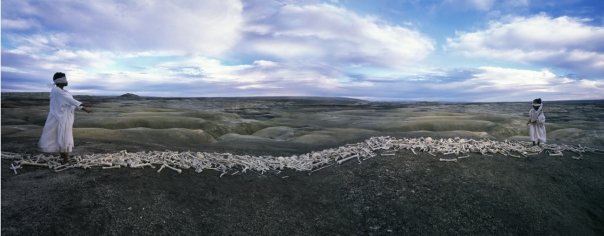
One Million Bones
One Million Bones: Art Against Genocide
Photographer Naomi Natale envisions ideas for social action art projects as One Million Bones in stark images. “I saw a picture of this massive mass grave and it haunted me and had a deep effect” – a thought closely followed by the urgent question, how can more awareness be brought to genocide happening around the world? She recalls first learning about the atrocities in Rwanda a full nine years after it happened, and wondering, why arent we taught more about this?
One Million Bones seeks to heighten awareness of and create change around the issue of genocide. Natale, recently teamed up with former Harwood Arts Director Susan McAllister to found the nonprofit The Art of Revolution, aspires to “create a noise thats impossible not to hear,” and have one million people create out of clay or plaster one bone to represent a victim of genocide. Then in the spring of 2013 each bone will be installed in the National Mall in Washington, D.C., recreating the haunting initial image of the mass grave. To raise funds, One Million Bones requests a sponsorship of $5 for each bone submitted in hopes of generating $5 million.
Another way to participate allows individuals who would like to be a part of the project but who cannot create a bone to make a $15 contribution that will enable a bone to be manufactured in their name. These bones will be constructed of biodegradable materials, impregnated with seeds, and planted to continue the cycle of awareness. Proceeds will be donated to the chosen beneficiary organizations: Genocide Intervention Network, The Enough! Project, and Women for Women International, which Natale describes as leaders in the international community known for their advocacy, education and policy, along with on the ground work in conflict zones.
Natale believes the “action” part of the large scale installation art project is a critical component that differentiates it from broad outreach education. When a person learns about something as horrifying as genocide, the reaction can be paralyzing and without the outlet to cope with such knowledge, a person may want to distance from it.”Ultimately this work is about preserving our humanity,” Natale says, “and we want people to take this issue thats far away and bring it home, home being inside of us.” Being able to do something, to create this bone as a symbol that is strong enough to “unite a human race” and know that the world will see it can help people connect more strongly with this issue and bring them into a more active role in the anti-genocide community. Once the community finds its voice around the issue of genocide, the publics will, she states, directs political will.”Symbolically, the bone is a testament of our common humanity and that we belong to each other.”
